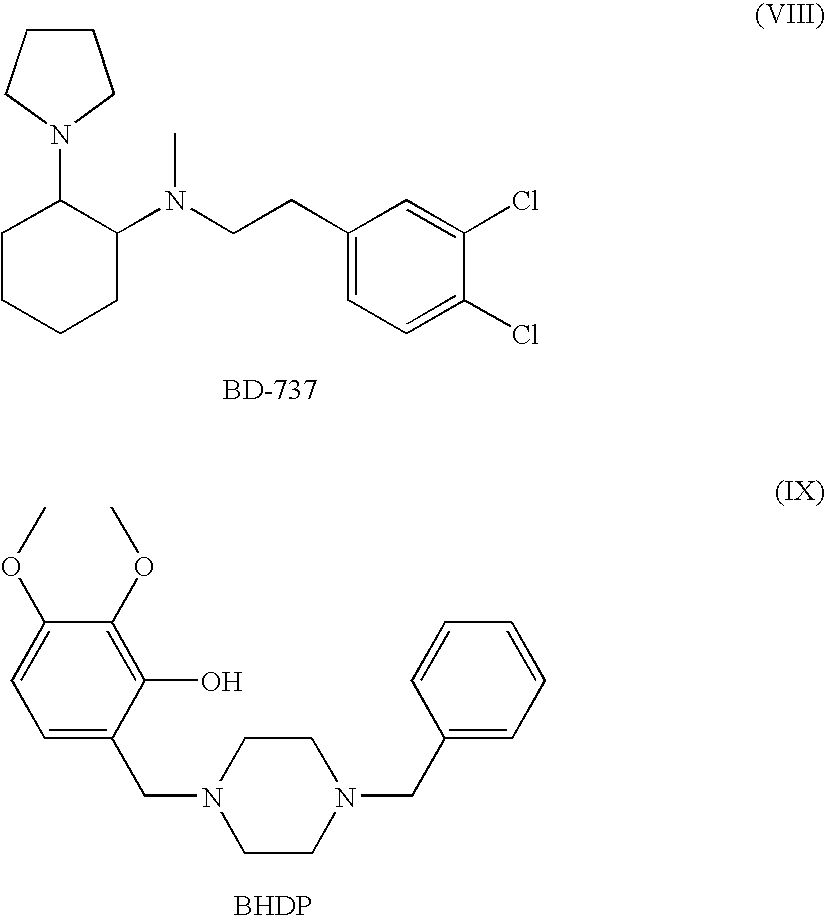Sigma ligands for neuronal regeneration and functional recovery
a neuronal regeneration and functional recovery technology, applied in the field of treatment, can solve problems such as paralysis, speech problems, dementia, etc., and achieve the effect of enhancing functional recovery and neuronal regeneration
- Summary
- Abstract
- Description
- Claims
- Application Information
AI Technical Summary
Benefits of technology
Problems solved by technology
Method used
Image
Examples
example 1
Animal Models for Neuronal Regeneration (Functional Recovery)
Male 3 months old SHR (spontaneous hypertensive) rats are used for induction of stroke by MCA occlusion. This is the preferred strain since most stroke patients are hypertensive. The animals are anesthetized with Methohexital and a small craniectomy is made above the zygmotic arch to expose the middle cerebral artery, which is occluded with a 10-0 monofilament nylon thread distal to the origin of the striatal branches. The rats are not intubated and no catheters are inserted. Following MCA occlusion a large and reproducible infarct is obtained, leading to a robust sensorimotor deficit. The animals are kept on a 6 hr light / 18 h dark cycle with free access to food and water. At two days after the MCAO the rats are treated with the compound I, II, III, IV, V, VI, VII, VIII, or IX (0.03-10 mg / kg) s.c. or p.o. and a control group is given saline for 2-8 weeks. At 2, 4, 6 and 8 weeks animals are tested in the rotating pole or...
example 2
Evidence of Neuronal Regeneration in Rats Treated with Siramesine
1. Morris Water Maze
The Morris water maze was used to assess functional recovery, in particular recovery in a cognitive skill, in hypertensive rats after exposure to permanent middle artery occlusion (MCAO), a model of ischemic stroke.
Forty three hypertensive rats were exposed to permanent middle artery occlusion (MCAO). Starting at two days after occlusion and continuing for 14 days, Siramesine was administered p.o. in doses of 0.3 mg / kg (14 rats) or 1.0 mg / kg (14 rats). In a control group (15 rats), vehicle only was administered. On day 35 after permanent MCAO, the rats were assessed for their performance in the Morris Water Maze Test.
In the test, the rats were given a series of 6 trials, 1 hour apart in a large dark-colored tank (200 cm in ) filled with clear water at a temperature of 22.0±1.5° C. A 12×12-cm submerged platform (2 mm below the water surface) was placed in the northwest quadrant of the pool. ...
example 3
Gene Expression Studies
The Ethics Committee for Animal Research at Lund University approved the experimental protocol. Six-month-old SHR (spontaneous hypertensive rats), obtained from Mollegard Breeding Center, Ejby, Denmark, 2 months earlier and preoperatively housed in standard cages (550×350×200 mm, 3 to 4 rats in each cage), were anesthetized with methohexital sodium (Brietal, 37° C.) 50 mg / kg intraperitoneally. The right MCA was accessed via a small craniotomy, and the artery was ligated distal to the striatal arteries, causing a neocortical infarct. The mean surgery time was about 20 minutes and body temperature was maintained close to 37° C. Postoperatively, rats were kept in individual cages for 24 hours. The rats subjected to MCA occlusion (MCAO) were either returned to standard environment (SE), or were placed in a large, vertical, enriched-environment (EE) cage (815×610×1,280 mm), equipped with horizontal and vertical boards, chains, swings, wooden blocks, and objects ...
PUM
| Property | Measurement | Unit |
|---|---|---|
| time | aaaaa | aaaaa |
| concentration | aaaaa | aaaaa |
| particle size | aaaaa | aaaaa |
Abstract
Description
Claims
Application Information
 Login to View More
Login to View More - R&D
- Intellectual Property
- Life Sciences
- Materials
- Tech Scout
- Unparalleled Data Quality
- Higher Quality Content
- 60% Fewer Hallucinations
Browse by: Latest US Patents, China's latest patents, Technical Efficacy Thesaurus, Application Domain, Technology Topic, Popular Technical Reports.
© 2025 PatSnap. All rights reserved.Legal|Privacy policy|Modern Slavery Act Transparency Statement|Sitemap|About US| Contact US: help@patsnap.com


